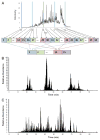Reversed-phase chromatography with multiple fraction concatenation strategy for proteome profiling of human MCF10A cells
- PMID: 21500348
- PMCID: PMC3120047
- DOI: 10.1002/pmic.201000722
Reversed-phase chromatography with multiple fraction concatenation strategy for proteome profiling of human MCF10A cells
Abstract
In this study, we evaluated a concatenated low pH (pH 3) and high pH (pH 10) reversed-phase liquid chromatography strategy as a first dimension for two-dimensional liquid chromatography tandem mass spectrometry ("shotgun") proteomic analysis of trypsin-digested human MCF10A cell sample. Compared with the more traditional strong cation exchange method, the use of concatenated high pH reversed-phase liquid chromatography as a first-dimension fractionation strategy resulted in 1.8- and 1.6-fold increases in the number of peptide and protein identifications (with two or more unique peptides), respectively. In addition to broader identifications, advantages of the concatenated high pH fractionation approach include improved protein sequence coverage, simplified sample processing, and reduced sample losses. The results demonstrate that the concatenated high pH reversed-phased strategy is an attractive alternative to strong cation exchange for two-dimensional shotgun proteomic analysis.
Copyright © 2011 WILEY-VCH Verlag GmbH & Co. KGaA, Weinheim.
Conflict of interest statement
The authors have declared no conflict of interest.
Figures



References
-
- Fang Y, Robinson DP, Foster LJ. Quantitative analysis of proteome coverage and recovery rates for upstream fractionation methods in proteomics. J Proteome Res. 2010;9:1902–1912. - PubMed
-
- Fournier ML, Gilmore JM, Martin-Brown SA, Washburn MP. Multidimensional separations-based shotgun proteomics. Chem Rev. 2007;107:3654–3686. - PubMed
-
- Washburn MP, Wolters D, Yates JR. Large-scale analysis of the yeast proteome by multidimensional protein identification technology. Nat Biotech. 2001;19:242–247. - PubMed
-
- Gilar M, Olivova P, Daly AE, Gebler JC. Orthogonality of separation in two-dimensional liquid chromatography. Anal Chem. 2005;77:6426–6434. - PubMed
Publication types
MeSH terms
Substances
Grants and funding
LinkOut - more resources
Full Text Sources
Other Literature Sources

